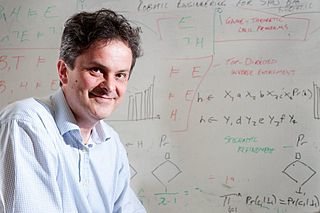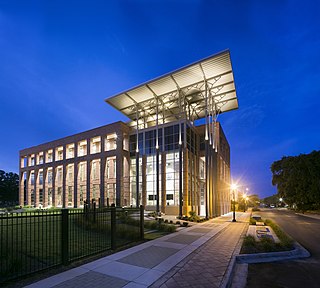Related Research Articles

Kevin Warwick is an English engineer and Deputy Vice-Chancellor (Research) at Coventry University. He is known for his studies on direct interfaces between computer systems and the human nervous system, and has also done research concerning robotics.
The Centrale Lyon, formerly École centrale de Lyon, is a research university in greater Lyon, France. Founded in 1857 by François Barthélemy Arlès-Dufour in response to the increasing industrialization of France, it is one of the oldest graduate schools in France. The university is part of the Grandes Écoles, a prestigious group of French institutions dedicated to engineering, scientific research, and business education. The current 45-acre campus opened in 1967 and is located in the city of Ecully.

The School of Informatics is an academic unit of the University of Edinburgh, in Scotland, responsible for research, teaching, outreach and commercialisation in informatics. It was created in 1998 from the former department of artificial intelligence, the Centre for Cognitive Science and the department of computer science, along with the Artificial Intelligence Applications Institute (AIAI) and the Human Communication Research Centre.
Developmental robotics (DevRob), sometimes called epigenetic robotics, is a scientific field which aims at studying the developmental mechanisms, architectures and constraints that allow lifelong and open-ended learning of new skills and new knowledge in embodied machines. As in human children, learning is expected to be cumulative and of progressively increasing complexity, and to result from self-exploration of the world in combination with social interaction. The typical methodological approach consists in starting from theories of human and animal development elaborated in fields such as developmental psychology, neuroscience, developmental and evolutionary biology, and linguistics, then to formalize and implement them in robots, sometimes exploring extensions or variants of them. The experimentation of those models in robots allows researchers to confront them with reality, and as a consequence, developmental robotics also provides feedback and novel hypotheses on theories of human and animal development.

The University of London Worldwide is the central academic body that manages external study programmes within the federal University of London. All courses are branded as simply "University of London", having previously been "University of London International Programmes" and earlier "University of London External Programmes". It claims to be the world's oldest distance and flexible learning body, established under the University of London's royal charter of 1858, although academics have disputed whether it offered distance learning at that time.

Stephen H. Muggleton is Professor of Machine Learning and Head of the Computational Bioinformatics Laboratory at Imperial College London.
In artificial intelligence, apprenticeship learning is the process of learning by observing an expert. It can be viewed as a form of supervised learning, where the training dataset consists of task executions by a demonstration teacher.
Damiano Brigo is a mathematician known for research in mathematical finance, filtering theory, stochastic analysis with differential geometry, probability theory and statistics, authoring more than 130 research publications and three monographs. From 2012 he serves as full professor with a chair in mathematical finance at the Department of Mathematics of Imperial College London, where he headed the Mathematical Finance group in 2012–2019. He is also a well known quantitative finance researcher, manager and advisor in the industry. His research has been cited and published also in mainstream industry publications, including Risk Magazine, where he has been the most cited author in the twenty years 1998–2017. He is often requested as a plenary or invited speaker both at academic and industry international events. Brigo's research has also been used in court as support for legal proceedings.

The Florida Institute for Human & Machine Cognition (IHMC) is a not-for-profit research institute of the State University System of Florida, with locations in Pensacola and Ocala, Florida. IHMC scientists and engineers investigate a broad range of topics related to building systems aimed at amplifying and extending human cognitive, physical and perceptual capacities.
Rehabilitation robotics is a field of research dedicated to understanding and augmenting rehabilitation through the application of robotic devices. Rehabilitation robotics includes development of robotic devices tailored for assisting different sensorimotor functions(e.g. arm, hand, leg, ankle), development of different schemes of assisting therapeutic training, and assessment of sensorimotor performance of patient; here, robots are used mainly as therapy aids instead of assistive devices. Rehabilitation using robotics is generally well tolerated by patients, and has been found to be an effective adjunct to therapy in individuals with motor impairments, especially due to stroke.
In neuroscience and motor control, the degrees of freedom problem or motor equivalence problem states that there are multiple ways for humans or animals to perform a movement in order to achieve the same goal. In other words, under normal circumstances, no simple one-to-one correspondence exists between a motor problem and a motor solution to the problem. The motor equivalence problem was first formulated by the Russian neurophysiologist Nikolai Bernstein: "It is clear that the basic difficulties for co-ordination consist precisely in the extreme abundance of degrees of freedom, with which the [nervous] centre is not at first in a position to deal."
As humans move through their environment, they must change the stiffness of their joints in order to effectively interact with their surroundings. Stiffness is the degree to a which an object resists deformation when subjected to a known force. This idea is also referred to as impedance, however, sometimes the idea of deformation under a given load is discussed under the term "compliance" which is the opposite of stiffness . In order to effectively interact with their environment, humans must adjust the stiffness of their limbs. This is accomplished via the co-contraction of antagonistic muscle groups.

Oussama Khatib is a roboticist and a professor of computer science at Stanford University, and a Fellow of the IEEE. He is credited with seminal work in areas ranging from robot motion planning and control, human-friendly robot design, to haptic interaction and human motion synthesis. His work's emphasis has been to develop theories, algorithms, and technologies, that control robot systems by using models of their physical dynamics. These dynamic models are used to derive optimal controllers for complex robots that interact with the environment in real-time.
Barbara H. Webb is a professor of robotics at the University of Edinburgh. She builds robotic models of insects.
The term “soft robots” designs a broad class of robotic systems whose architecture includes soft elements, with much higher elasticity than traditional rigid robots. Articulated Soft Robots are robots with both soft and rigid parts, inspired to the muscloloskeletal system of vertebrate animals – from reptiles to birds to mammalians to humans. Compliance is typically concentrated in actuators, transmission and joints while structural stability is provided by rigid or semi-rigid links.

Information engineering is the engineering discipline that deals with the generation, distribution, analysis, and use of information, data, and knowledge in electrical systems. The field first became identifiable in the early 21st century.
Marina Umaschi Bers is the Augustus Long Professor of Education at Boston College. Bers holds a secondary appointment in Boston College's Department of Computer Science. Bers directs the interdisciplinary DevTech Research Group, which she started in 2001 at Tufts University. Her research involves the design and study of innovative learning technologies to promote children's positive development. She is known for her work in the field of early childhood computer science with projects of national and international visibility. Bers is the co-creator of the free ScratchJr programming language, used by 35 million children, and the creator of the KIBO robotic kit, which has no screens or keyboards.
Sami Haddadin is a German electrical engineer, computer scientist, and university professor specializing in robotics and artificial intelligence. Since April 2018, he has served as the executive director of the Munich Institute of Robotics and Machine Intelligence (MIRMI) at the Technical University of Munich (TUM), where he also holds the Chair of Robotics and Systems Intelligence.
David John Noel Limebeer is an electrical engineer and academic. He is an Emeritus Professor of Control Engineering at the University of Oxford and a Distinguished Professor at the University of the Witwatersrand. He is also an Emeritus Professorial Fellow at New College, Oxford.
Stephen Roberts FREng is a British academic and scientist. He is a professor of machine learning at University of Oxford and leads the Machine Learning Research Group, a sub-group of the Department of Engineering Science.
References
- ↑ "Home - Professor Etienne Burdet".
- ↑ Burdet, Etienne; Osu, Rieko; Franklin, David W.; Milner, Theodore E.; Kawato, Mitsuo (November 2001). "The central nervous system stabilizes unstable dynamics by learning optimal impedance". Nature. 414 (6862): 446–449. Bibcode:2001Natur.414..446B. doi:10.1038/35106566. PMID 11719805. S2CID 559162.